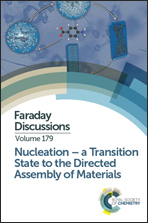Modelling the stochastic behaviour of primary nucleation
Abstract
We study the stochastic nature of primary nucleation and how it manifests itself in a crystallisation process at different scales and under different operating conditions. Such characteristics of nucleation are evident in many experiments where detection times of crystals are not identical, despite identical experimental conditions, but instead are distributed around an average value. While abundant experimental evidence has been reported in the literature, a clear theoretical understanding and an appropriate modelling of this feature is still missing. In this contribution, we present two models describing a batch cooling crystallisation, where the interplay between stochastic nucleation and deterministic crystal growth is described differently in each. The nucleation and growth rates of the two models are estimated by a comprehensive set of measurements of paracetamol crystallisation from aqueous solution in a 1 mL vessel [Kadam et al., Chemical Engineering Science, 2012, 72, 10–19]. Both models are applied to the cooling crystallisation process above under different operating conditions, i.e. different volumes, initial concentrations, cooling rates. The advantages and disadvantages of the two approaches are illustrated and discussed, with particular reference to their use across scales of nucleation rate measured in very small crystallisers.
- This article is part of the themed collection: Nucleation – a Transition State to the Directed Assembly of Materials

 Please wait while we load your content...
Please wait while we load your content...